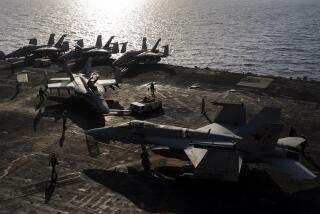2 Carriers May Be Cut if Navy Loses $60 Billion : Defense: Service lists its contingency spending reduction plans. Naval strategy may have to be revised.
- Share via
WASHINGTON — The Navy, in a step that would virtually erase the effects of the Ronald Reagan Administration’s naval build-up, has proposed reducing its fleet of aircraft carriers from 14 to 12 if the service is required to cut $60 billion from its budget over three years, defense officials said Tuesday.
In a meeting Tuesday with Defense Secretary Dick Cheney, Adm. Carlisle A. H. Trost, who is chief of naval operations, warned that the smaller fleet would force the United States to revise its naval strategy.
The Navy has also proposed mothballing its four World War II-era battleships as part of a budget-cutting exercise. It said that, if further reductions are demanded, it will have to consider the early retirement of its first nuclear-powered aircraft carrier, the Enterprise.
The Navy’s proposal is part of a package of savings designed to cut $180 billion from the Pentagon’s 1992-94 budget plans. Cheney, citing congressional pressure to reduce the deficit and a changed military situation in Eastern Europe, asked each branch of the military to draw up contingency plans early last week.
Trost has called aircraft carriers “the backbone of the Navy.” The loss of two carriers would decisively end the service’s eight-year effort to build a fleet capable of carrying a war into Soviet harbors.
In issuing orders for the services to draw up budgetary contingency plans, Cheney did not tell the services what military missions they would be expected to accomplish. In the absence of such guidelines, Navy officials have said, they are uncertain as to which of their forces to cut.
“You give the Navy a mission and they can tell you how many ships they’ll need,” one Navy official said.
However, under pressure to present a contingency plan, the Navy proposed that the aircraft carrier Midway, commissioned in 1945, be mothballed in 1991. The retirement of the 33-year-old aircraft carrier Saratoga would be accelerated from 1997 to as early as 1993.
The Enterprise, due to begin a $2-billion nuclear refueling in 1991, might have to be retired if further cuts are ordered, the Navy told Cheney and his budget analysts. Congress has approved all funds for the refueling project, and more than $450 million has been spent already.
Even if the Enterprise is not retired, it will be out of commission for 18 months for the refueling, scheduled to begin in January, 1991.
Meanwhile, the Army has proposed cutting as many as 200,000 troops--including a division in Europe. The Air Force has proposed slowing down production of the B-2 bomber and putting some B-52 bombers and Minuteman 2 missiles into early retirement.
The Navy proposal probably would gain some support on Capitol Hill, where lawmakers have pressed the service to find savings through early retirements of carriers.
“In light of the changing threat and shrinking defense budget, we may have to reduce the number of carrier battle groups in order to ensure that the carriers that we do deploy are fully manned, armed and escorted,” said Sen. Edward M. Kennedy (D-Mass.), chairman of the Senate Armed Services Committee’s subcommittee on sea power. “We have to make smart choices with our limited defense dollars to produce a balanced, capable force.”
However, other lawmakers expressed concern about Cheney’s effort to recast the Pentagon’s 1992-94 budget plans.
Strategy considerations have not been “nearly enough” of a factor in the current budget deliberations, Sen. John McCain (R-Ariz.) said.
“It seems to me a reevaluation of our roles, missions and commitments is necessary to find out what these national security issues are,” McCain said. Cheney should “start there and shape a defense establishment around that conclusion, instead of (issuing) across-the-board proportional cuts to all three services.”
On ABC’s “This Week with David Brinkley” on Sunday, Cheney said he believes that the prospect of an all-out military attack on Western Europe, with the active cooperation of East Germany, Poland and Hungary, is “now pretty remote.”
More to Read
Sign up for Essential California
The most important California stories and recommendations in your inbox every morning.
You may occasionally receive promotional content from the Los Angeles Times.














